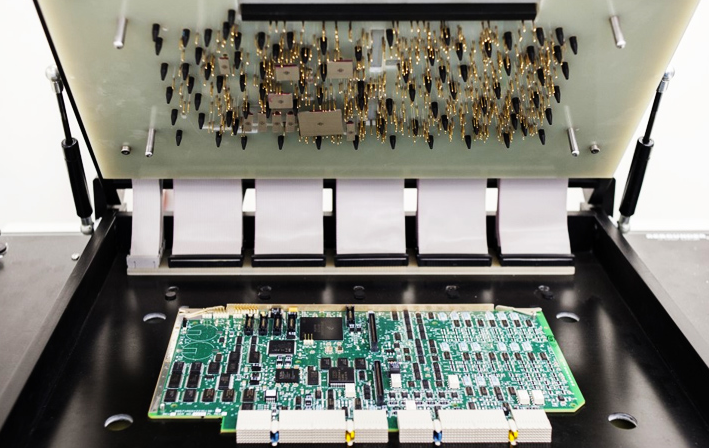7 common PCBA circuit board performance tests
PCBA circuit board performance test is a necessary test to ensure stable product performance after PCBA processing is completed. According to the actual use environment and purpose of the product, it is generally divided into withstand voltage test, insulation test, salt spray test, impedance test, vibration test, high temperature and high humidity Test, welding strength thrust test, etc. Below we give a detailed introduction to these 7 PCBA circuit board performance tests.
1. Withstand voltage test
The purpose of the withstand voltage test is to detect the withstand voltage capability of the circuit board, and the equipment that needs to be used is the "withstand voltage tester".
Test method: Connect the PCBA circuit board to be tested to the tester, increase the voltage to 500V DS (direct current) at a speed not higher than 100V/S, and keep it for more than 30 seconds. If the circuit has no fault, it means the test has passed.
2. Leakage current test
The purpose of the leakage current test is to check whether the leakage current of the circuit board is within the requirements. The equipment that needs to be used is a "leakage current tester".
Test method: Simulate the leakage current between the contactable part of the product and the two poles of the power supply under the normal working condition of the PCBA circuit board and the normal temperature of the circuit board. If the current is less than the design standard, it means the test has passed.

3. Salt spray test
The purpose of the salt spray test is to check the anti-corrosion performance of the circuit board. The equipment that needs to be used is the "salt spray test machine"
Test method: First, we need to configure the salt solution, the configuration method is: use chemically pure sodium chloride and resistivity not less than 5000 ohm*CM distilled water or deionized water, use 5% sodium chloride and 95% water, After thorough mixing, a salt solution with a sodium chloride content of 5±1% is made. After the salt solution is configured, it is sprayed continuously for 48 hours in a test place at a temperature of 35°C. The average spray volume per hour must reach 80cm square/10cm. After 48 hours, the product functions are normal, and the appearance and structure are normal. It means the test passed.
4. Impedance test
The purpose of impedance test is to check whether the circuit board circuit can operate normally, and the equipment that needs to be used is an "ohmmeter"
Test method: Connect the transmission line of the circuit board to the battery. If we measure the impedance in a shorter time than the reflection of the transmission line, we will get the "surge" impedance or characteristic impedance, but if the waiting time is long enough until the energy is reflected After returning and receiving, the impedance can be found to change after measurement. Generally speaking, the impedance value will reach a stable limit value after rebounding up and down. If the limit value is within the specified range, it means the test has passed.
5. Vibration test
The purpose of the vibration test is to detect whether the circuit board can pass the random vibration test of different levels. The equipment that needs to be used is a "vibration meter"
Test method: Fix the circuit board or the packaged circuit board on the test bench, set the frequency to 20Hz, axis: X, Y, Z three axis, the duration is one hour in each direction, a total of three hours, the test is over Later, if the circuit board functions normally, the appearance and structure are normal, and there is no abnormal soldering or cracking of the components, it means that the test has passed.
6. High temperature and humidity test
The purpose of the high temperature and humidity test is to check the applicability of the circuit board under the harsh conditions of high temperature and humidity. The equipment needed is a "constant temperature and humidity test chamber".
Test method: PCBA circuit board is in the working condition of double rated voltage and rated load, put it into the test box in working attitude to simulate the temperature and humidity conditions during actual work, if you do not know the temperature and humidity during actual work, you can set The temperature is 70±2 degree Celsius, the humidity is between 90-95%, and it works continuously for 8 hours. If the basic function of the PCBA circuit board is normal, and the appearance and structure are normal, it means the test has passed.
7. Welding strength thrust test
The purpose of the welding strength thrust test is to test whether the welding strength of the components meets the requirements, and the equipment that needs to be used is the "thrust meter"
Test method: Place the soldered PCBA circuit board on the thrust gauge. Components of different specifications have different passing requirements. Generally, we will eliminate other components on the edge of the target component, and then reset the instrument to zero to ≤30 degrees Perform thrust test on the corner to check whether the components are unsoldered, and record the value of the unsoldering of the components.
The thrust standards of commonly used specifications are: 0402 specification components: 0.65Kgf, 0603 specification components: 1.20Kgf, 0805 specification components, thrust standards: 2.30Kgf, 1206 specification components The thrust standard is: 3.00Kgf.
The above are the 7 common PCBA circuit board performance test methods. You can choose different test methods according to the actual situation of your products.